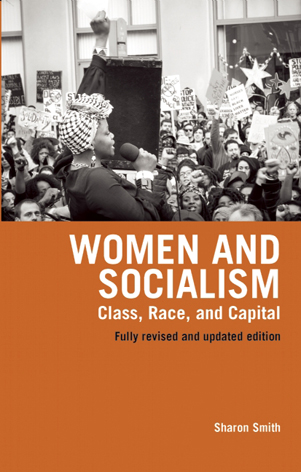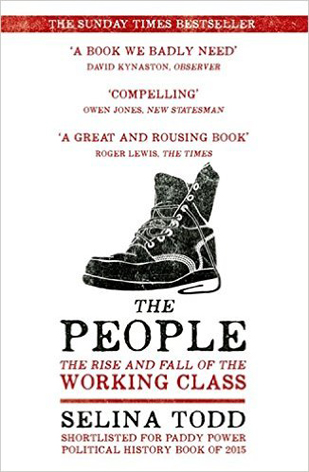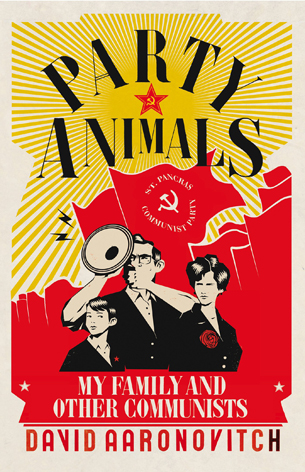Book Reviews: ‘Women and Socialism’, ‘The People’, & ‘Party Animals’
Votes for some women
‘Women and Socialism: Class, Race, and Capital’. By Sharon Smith. Haymarket Books. 2016
 This is a ‘fully revised’ re-edition, with a new subtitle, of a book with the same title that came out in 2004 by an American Trotskyist. In the meantime Smith had revised her previous derogatory attitude towards ‘middle class feminists’ (who merely want equality under capitalism). She also wanted to emphasise more her view that there is a need to unify feminist and black struggles.
This is a ‘fully revised’ re-edition, with a new subtitle, of a book with the same title that came out in 2004 by an American Trotskyist. In the meantime Smith had revised her previous derogatory attitude towards ‘middle class feminists’ (who merely want equality under capitalism). She also wanted to emphasise more her view that there is a need to unify feminist and black struggles.
One interesting fact that emerges from a couple of passages is that we were not alone in opposing the suffragettes, who were demanding votes for women on the same terms as men then had, for wanting ‘Votes for Rich Women’. Some in the German Social Democratic movement took the same position in regard to the same demand in Germany (where universal male suffrage did not exist either). Smith tells us:
‘… the early-twentieth-century German women’s suffrage movement did not challenge the property requirements that denied working-class men the right to vote – knowing that such requirements would also deny voting rights to working-class women. Maintaining such property requirements could only strengthen the political weight of the middle and upper classes, while the working class would remain politically voiceless.’
and
‘Some women’s suffrage organizations demanded (and in some European countries, won) partial suffrage for women – with voting rights based upon property holding and the payment of taxes (that is, restricting voting rights to those women of financial means). But in many of these same societies, male suffrage was also partial, denying working-class men the right to vote. Thus, partial suffrage merely increased the voting power of the upper classes.’
In the USA universal male and female suffrage was instituted in 1920 but only on paper in the ex-Confederate States where black men let alone black women were excluded under various pretexts, an anomaly not put right until the Civil Rights Movement of the 1960s. Smith sees not insisting on this at the time as a failure on the part of earlier feminists which, she argues, should now be rectified by seeing the black and women’s equality movements as part of the same struggle. Multi-identity – gays and lesbians are invited to join too – politics, if you like, instead of class politics.
She argues that the basis for women’s equality has to be pay for housework. But this is not going to happen under capitalism and won’t be necessary in socialism where people won’t have to have a money income to access the goods and services they need. Instead, the principle ‘from each according to their ability, to each according to their needs’ will apply, a much better and more rational way of putting women and men in a position of equality in that respect.
ALB
************************************************************
But Which People?
‘The People: The Rise and Fall of the Working Class’. By Selina Todd. (John Murray £10.99)
 This is intended as a history of the working class in the UK from 1910 to 2010. Although Todd’s view of who counts as working class is not always clear, she appears to see it as primarily manual workers, so only part of the story is presented here. However, she is quite right when she describes class as ‘a relationship defined by unequal power, rather than a way of life or an unchanging culture’.
This is intended as a history of the working class in the UK from 1910 to 2010. Although Todd’s view of who counts as working class is not always clear, she appears to see it as primarily manual workers, so only part of the story is presented here. However, she is quite right when she describes class as ‘a relationship defined by unequal power, rather than a way of life or an unchanging culture’.
The narrative she provides can be summarised as follows. In the early part of the last century, there were nearly one and a half million domestic servants, the largest group of workers. Factory workers tended to be regarded as unskilled (and so lower-paid) if any of their work involved using machinery. In the First World War, domestic servants almost disappeared as women went to work in munitions factories and joined unions; they often resented being forced back into ‘service’ after the war. The defeat of the General Strike meant that the labour movement supposedly became committed to constitutional change, with workers’ strength not being used as a political weapon.
The thirties saw Depression, unemployment and the Means Test, and the number of servants increased slightly, as women whose fathers were out of work had to find employment somewhere. Families were broken up, and many people slid down the social ladder, with apprenticeships rarely leading to a skilled job. By the mid-thirties, things were improving for many workers, though by no means all. Mass production on assembly lines was a new development, imported from the US.
The Second World War was ‘the people’s war’, and many workers benefited from increased wages and job security. Their lives improved even more after the war, with higher wages and ‘full employment’. One area where there was little progress, however, was housing, with not enough houses built and council housing generally inferior to private building. By 1951, the metal industry employed 15 percent of male workers. By the late fifties, many working-class families experienced a reasonable standard of living, but only if they had two parents working overtime and relying on debt, especially hire purchase.
From around that same time a cultural revolution took place, by which being working class supposedly became fashionable (as seen in novels such as Room at the Top). In the late sixties, workers became readier to strike for higher wages, and many women got involved in rent strikes as council rents rose. In the eighties, the government attacked unions, most notably in the miners’ strike, and cut social security, leading to increases in inequality. It was no longer clear that children could look forward to better lives than their parents had known. By 2000, 70 percent of workers were employed in non-manual work, yet a growing number of people saw themselves as working class.
As this suggests, there is a lot of useful material here, enlivened by reference to, and quotes from, surveys and interviews with workers, many carried out by Mass Observation. But there is an unfortunate tendency to romanticise the post-1945 era and exaggerate its ongoing effect on the lives of the great majority. We are told that ‘etween 1945 and 1951 the lives of working-class people greatly improved’, but then that ‘the 1950s were a decade of insecurity and fear for many people’. And the book is a bit naive in places, such as the claim that by the end of the seventies the main political parties had made a ‘decision to govern in favour of capitalists rather than in the interests of the majority of the electorate’: when was it ever any different?
An afterword takes the story up to 2015, and is in some ways rather more convincing, as in the statement that ‘class arises from the conflicts between different groups, who are defined primarily by their relationship to the means of production. In capitalism, the profits of the few depend on the exploitation of the many’. A consistent approach to class, with little or no reference to a vaguely-defined middle class, would have made this a better book.
PB
************************************************************
Family Circle
‘Party Animals: My Family and Other Communists’. By David Aaronovitch. (Jonathan Cape. 2016)
 Aaronovitch is not, it is fair to say, universally popular as a political columnist but this book shows another side to a quite complex individual, centered on his upbringing and early life in the Communist Party of Great Britain. It is for the most part engaging and well written and there is much here that anyone familiar with radical and revolutionary politics will be able to identify with.
Aaronovitch is not, it is fair to say, universally popular as a political columnist but this book shows another side to a quite complex individual, centered on his upbringing and early life in the Communist Party of Great Britain. It is for the most part engaging and well written and there is much here that anyone familiar with radical and revolutionary politics will be able to identify with.
His father was Sam Aaronovitch, a working class full-time Communist Party official who later became an academic, while his mother Lavender was a radical activist and equally fervent in her leftist and pro-Soviet views. They were contemporaries of well-known CPGB activists like John Gollan, Jock Nicholson and Peter Fryer, and Aaronovitch deftly analyses their North London social and political milieu. This book is an attempt to explain why they thought as they did and to explore the cultural environment and reference points of those who set themselves in this way outside the mainstream of society. In this respect, it is a personal exploration of what it means to be ‘the other’ and how political ideology was reflected in music, holidays, food eaten and a range of other ostensibly non-political activities that were nevertheless impacted by the sense of being different and apart from the mainstream.
While the CPGB had its own distinctive internal culture and identity it would be churlish to deny there is a wider resonance here of sorts, including with organisations like the SPGB that have had a similar ancestry in the self-educated working class ‘autodidactic’ tradition. This has been a tradition often at variance to the prevailing attitudes and codes of behaviour in society (from say, negative feelings towards religion, to refusing to sing the national anthem at school).
In some respects there are interesting parallels with the approach taken in Alexei Sayle’s ‘Stalin Ate My Homework’, though compared to Sayle what this loses in humour it perhaps gains in terms of psychological insight. Aaronovitch is impressive in his analysis of psychological attitudes and responses in the CPGB towards the Hungarian Uprising of 1956 (including why some members left at this time while others reconciled themselves to stay), the Czechoslovakian events of 1968 and then the long decline of the CPGB from the 1970s. He takes in the split with the hardline so-called ‘tankies’ in 1977 and the final dissolution of the organization in 1991 with the founding of the Democratic Left. But by then the Party had been over for him for some time and this book is the culmination of many years – decades even – of soul-searching about his upbringing and involvement in it.
Some of what emerges about Aaronvitch’s family background is clearly uncomfortable (his father was an adulterer and it appears that the family were the thinly-disguised subject of a chapter in a well-known book by the psychologist Robyn Skinner, consequent on a series of family therapy sessions they had with him). There is a sense of some score-settling too as the book progresses, though this doesn’t detract too much from what is an otherwise insightful work. It is mainly an autobiographical and sociological account rather than an expressly political one perhaps, and it would have been interesting to have explored more closely at times the political assumptions that lay behind the belief in so-called ‘actually existing socialism’ in the Soviet Union and its satellites. For this was not a ‘socialism’ that degenerated over time, but a complete mirage from the outset, and one the CPGB were at pains to promote and uphold despite all the evidence to the contrary from 1917 onwards.
DAP
